OUMH1303 English for Oral Communication: Motivation Speech
VerifiedAdded on 2022/11/25
|6
|2113
|310
Presentation
AI Summary
This assignment presents a speech on the significance of motivation in the workplace, targeting department staff. The speech emphasizes motivation's key role in organizational success, highlighting its psychological aspects and the need for alignment with the dynamic business environment. It covers essential elements like communication, fostering a healthy workplace culture, and employee engagement through team-building activities and surveys to understand individual needs. The speech stresses the importance of adapting to changes, viewing failure as a learning opportunity, and maintaining high morale. It also discusses incentives, including monetary rewards, promotions, and open communication channels for suggestions. The conclusion reinforces the importance of coordination, motivation, individual performance, and a positive work environment for overall success, urging collaboration among team members and addressing cultural and language differences. The speech is supported by several academic references.
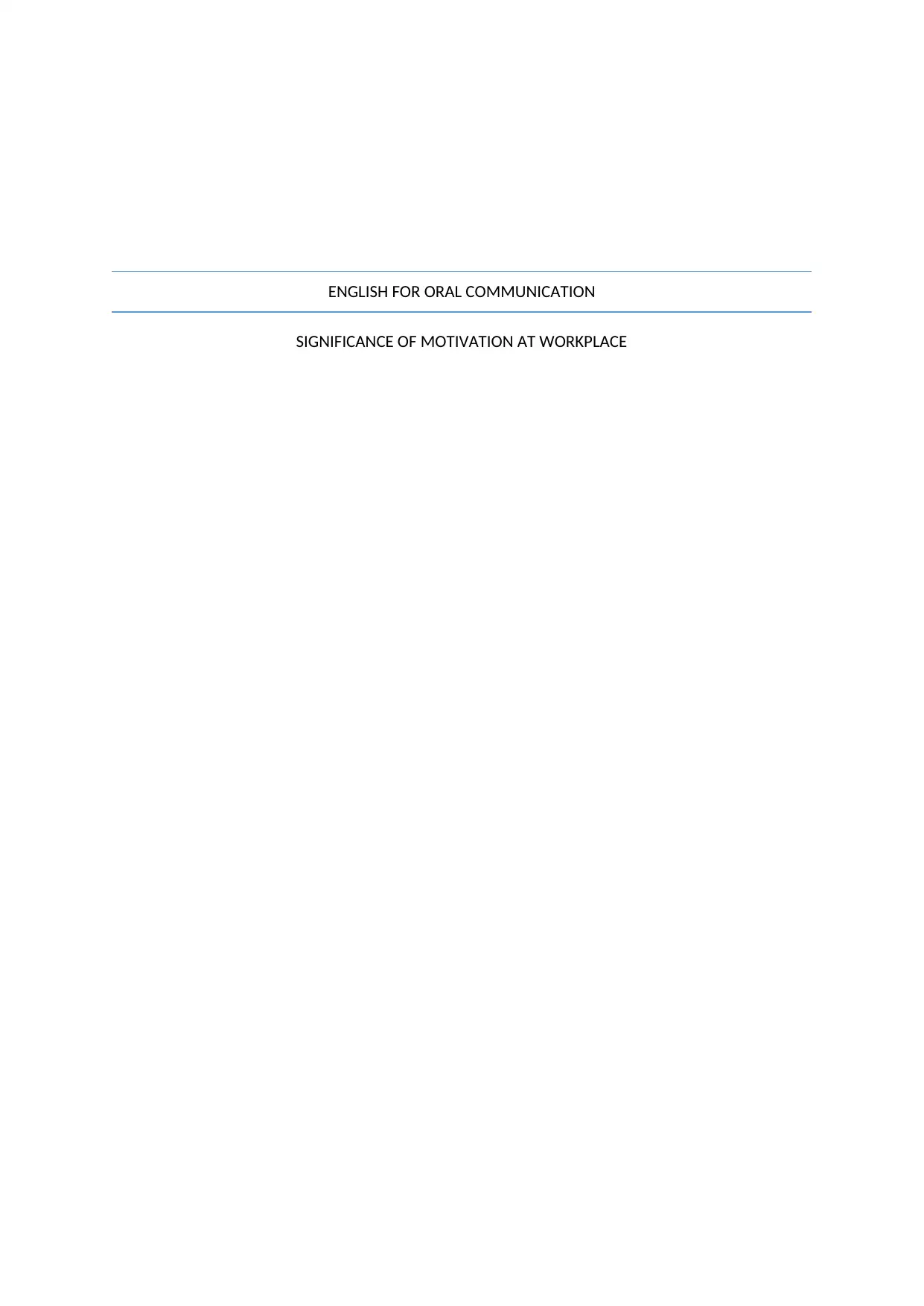
ENGLISH FOR ORAL COMMUNICATION
SIGNIFICANCE OF MOTIVATION AT WORKPLACE
SIGNIFICANCE OF MOTIVATION AT WORKPLACE
Paraphrase This Document
Need a fresh take? Get an instant paraphrase of this document with our AI Paraphraser
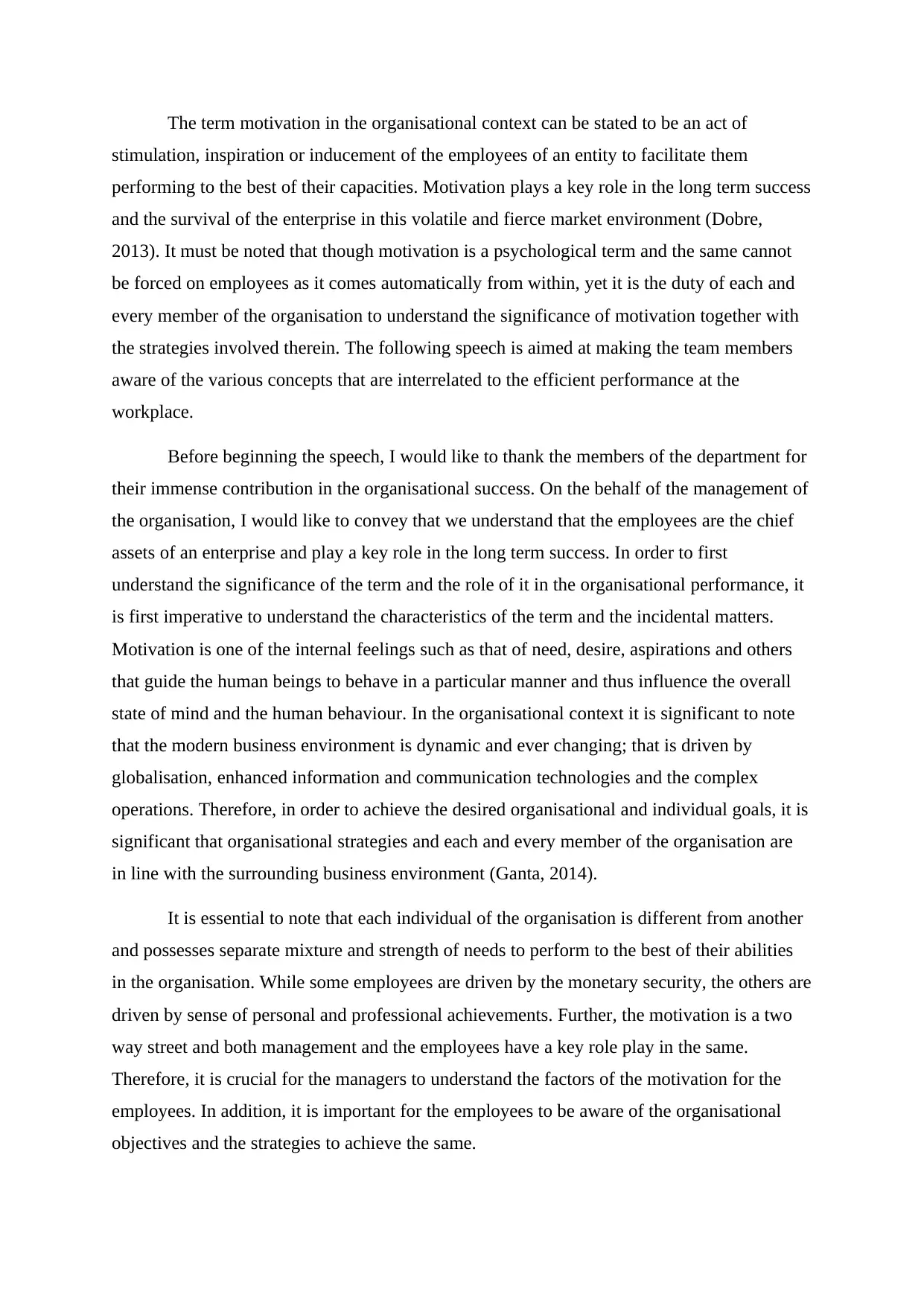
The term motivation in the organisational context can be stated to be an act of
stimulation, inspiration or inducement of the employees of an entity to facilitate them
performing to the best of their capacities. Motivation plays a key role in the long term success
and the survival of the enterprise in this volatile and fierce market environment (Dobre,
2013). It must be noted that though motivation is a psychological term and the same cannot
be forced on employees as it comes automatically from within, yet it is the duty of each and
every member of the organisation to understand the significance of motivation together with
the strategies involved therein. The following speech is aimed at making the team members
aware of the various concepts that are interrelated to the efficient performance at the
workplace.
Before beginning the speech, I would like to thank the members of the department for
their immense contribution in the organisational success. On the behalf of the management of
the organisation, I would like to convey that we understand that the employees are the chief
assets of an enterprise and play a key role in the long term success. In order to first
understand the significance of the term and the role of it in the organisational performance, it
is first imperative to understand the characteristics of the term and the incidental matters.
Motivation is one of the internal feelings such as that of need, desire, aspirations and others
that guide the human beings to behave in a particular manner and thus influence the overall
state of mind and the human behaviour. In the organisational context it is significant to note
that the modern business environment is dynamic and ever changing; that is driven by
globalisation, enhanced information and communication technologies and the complex
operations. Therefore, in order to achieve the desired organisational and individual goals, it is
significant that organisational strategies and each and every member of the organisation are
in line with the surrounding business environment (Ganta, 2014).
It is essential to note that each individual of the organisation is different from another
and possesses separate mixture and strength of needs to perform to the best of their abilities
in the organisation. While some employees are driven by the monetary security, the others are
driven by sense of personal and professional achievements. Further, the motivation is a two
way street and both management and the employees have a key role play in the same.
Therefore, it is crucial for the managers to understand the factors of the motivation for the
employees. In addition, it is important for the employees to be aware of the organisational
objectives and the strategies to achieve the same.
stimulation, inspiration or inducement of the employees of an entity to facilitate them
performing to the best of their capacities. Motivation plays a key role in the long term success
and the survival of the enterprise in this volatile and fierce market environment (Dobre,
2013). It must be noted that though motivation is a psychological term and the same cannot
be forced on employees as it comes automatically from within, yet it is the duty of each and
every member of the organisation to understand the significance of motivation together with
the strategies involved therein. The following speech is aimed at making the team members
aware of the various concepts that are interrelated to the efficient performance at the
workplace.
Before beginning the speech, I would like to thank the members of the department for
their immense contribution in the organisational success. On the behalf of the management of
the organisation, I would like to convey that we understand that the employees are the chief
assets of an enterprise and play a key role in the long term success. In order to first
understand the significance of the term and the role of it in the organisational performance, it
is first imperative to understand the characteristics of the term and the incidental matters.
Motivation is one of the internal feelings such as that of need, desire, aspirations and others
that guide the human beings to behave in a particular manner and thus influence the overall
state of mind and the human behaviour. In the organisational context it is significant to note
that the modern business environment is dynamic and ever changing; that is driven by
globalisation, enhanced information and communication technologies and the complex
operations. Therefore, in order to achieve the desired organisational and individual goals, it is
significant that organisational strategies and each and every member of the organisation are
in line with the surrounding business environment (Ganta, 2014).
It is essential to note that each individual of the organisation is different from another
and possesses separate mixture and strength of needs to perform to the best of their abilities
in the organisation. While some employees are driven by the monetary security, the others are
driven by sense of personal and professional achievements. Further, the motivation is a two
way street and both management and the employees have a key role play in the same.
Therefore, it is crucial for the managers to understand the factors of the motivation for the
employees. In addition, it is important for the employees to be aware of the organisational
objectives and the strategies to achieve the same.
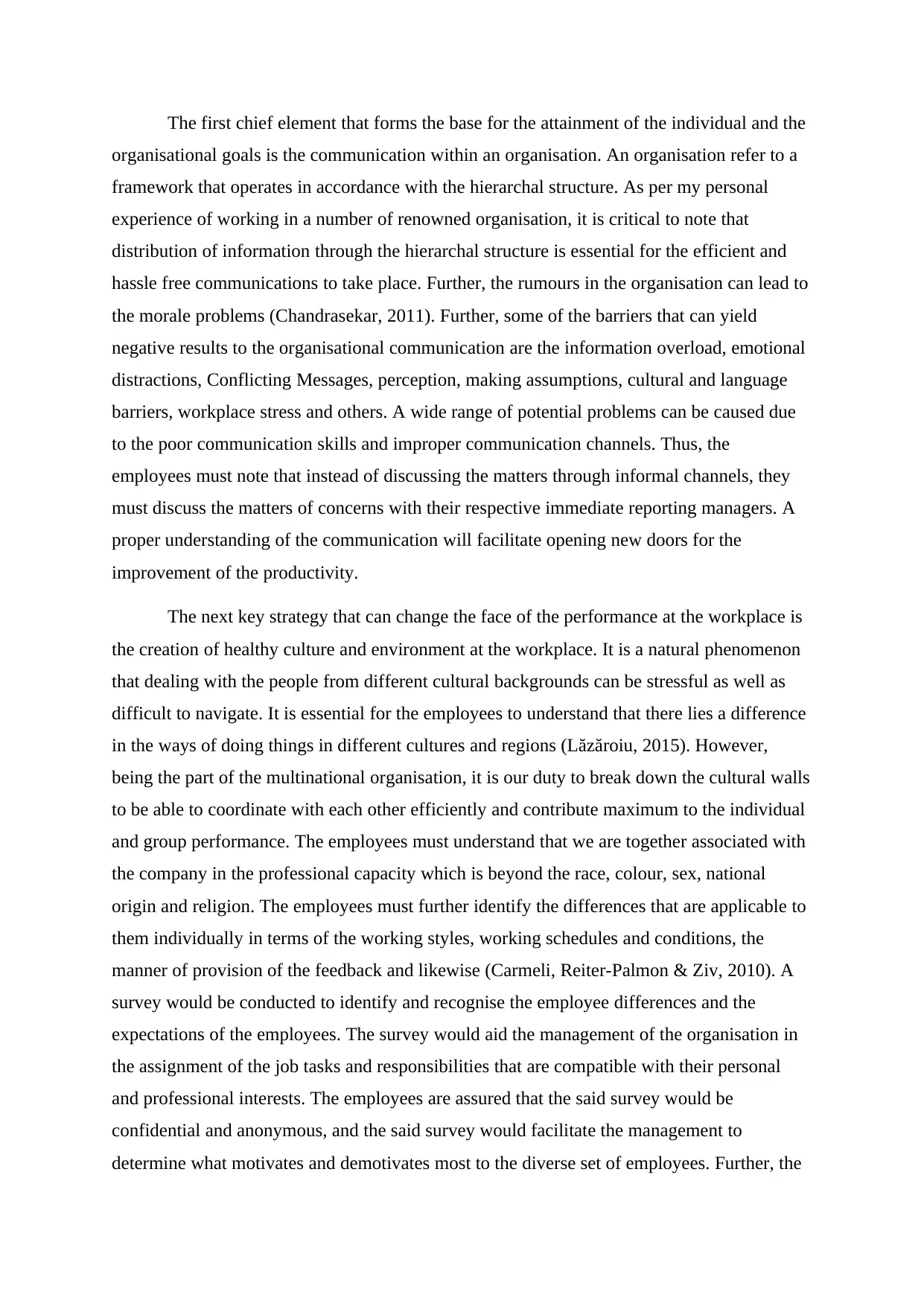
The first chief element that forms the base for the attainment of the individual and the
organisational goals is the communication within an organisation. An organisation refer to a
framework that operates in accordance with the hierarchal structure. As per my personal
experience of working in a number of renowned organisation, it is critical to note that
distribution of information through the hierarchal structure is essential for the efficient and
hassle free communications to take place. Further, the rumours in the organisation can lead to
the morale problems (Chandrasekar, 2011). Further, some of the barriers that can yield
negative results to the organisational communication are the information overload, emotional
distractions, Conflicting Messages, perception, making assumptions, cultural and language
barriers, workplace stress and others. A wide range of potential problems can be caused due
to the poor communication skills and improper communication channels. Thus, the
employees must note that instead of discussing the matters through informal channels, they
must discuss the matters of concerns with their respective immediate reporting managers. A
proper understanding of the communication will facilitate opening new doors for the
improvement of the productivity.
The next key strategy that can change the face of the performance at the workplace is
the creation of healthy culture and environment at the workplace. It is a natural phenomenon
that dealing with the people from different cultural backgrounds can be stressful as well as
difficult to navigate. It is essential for the employees to understand that there lies a difference
in the ways of doing things in different cultures and regions (Lăzăroiu, 2015). However,
being the part of the multinational organisation, it is our duty to break down the cultural walls
to be able to coordinate with each other efficiently and contribute maximum to the individual
and group performance. The employees must understand that we are together associated with
the company in the professional capacity which is beyond the race, colour, sex, national
origin and religion. The employees must further identify the differences that are applicable to
them individually in terms of the working styles, working schedules and conditions, the
manner of provision of the feedback and likewise (Carmeli, Reiter-Palmon & Ziv, 2010). A
survey would be conducted to identify and recognise the employee differences and the
expectations of the employees. The survey would aid the management of the organisation in
the assignment of the job tasks and responsibilities that are compatible with their personal
and professional interests. The employees are assured that the said survey would be
confidential and anonymous, and the said survey would facilitate the management to
determine what motivates and demotivates most to the diverse set of employees. Further, the
organisational goals is the communication within an organisation. An organisation refer to a
framework that operates in accordance with the hierarchal structure. As per my personal
experience of working in a number of renowned organisation, it is critical to note that
distribution of information through the hierarchal structure is essential for the efficient and
hassle free communications to take place. Further, the rumours in the organisation can lead to
the morale problems (Chandrasekar, 2011). Further, some of the barriers that can yield
negative results to the organisational communication are the information overload, emotional
distractions, Conflicting Messages, perception, making assumptions, cultural and language
barriers, workplace stress and others. A wide range of potential problems can be caused due
to the poor communication skills and improper communication channels. Thus, the
employees must note that instead of discussing the matters through informal channels, they
must discuss the matters of concerns with their respective immediate reporting managers. A
proper understanding of the communication will facilitate opening new doors for the
improvement of the productivity.
The next key strategy that can change the face of the performance at the workplace is
the creation of healthy culture and environment at the workplace. It is a natural phenomenon
that dealing with the people from different cultural backgrounds can be stressful as well as
difficult to navigate. It is essential for the employees to understand that there lies a difference
in the ways of doing things in different cultures and regions (Lăzăroiu, 2015). However,
being the part of the multinational organisation, it is our duty to break down the cultural walls
to be able to coordinate with each other efficiently and contribute maximum to the individual
and group performance. The employees must understand that we are together associated with
the company in the professional capacity which is beyond the race, colour, sex, national
origin and religion. The employees must further identify the differences that are applicable to
them individually in terms of the working styles, working schedules and conditions, the
manner of provision of the feedback and likewise (Carmeli, Reiter-Palmon & Ziv, 2010). A
survey would be conducted to identify and recognise the employee differences and the
expectations of the employees. The survey would aid the management of the organisation in
the assignment of the job tasks and responsibilities that are compatible with their personal
and professional interests. The employees are assured that the said survey would be
confidential and anonymous, and the said survey would facilitate the management to
determine what motivates and demotivates most to the diverse set of employees. Further, the
⊘ This is a preview!⊘
Do you want full access?
Subscribe today to unlock all pages.

Trusted by 1+ million students worldwide
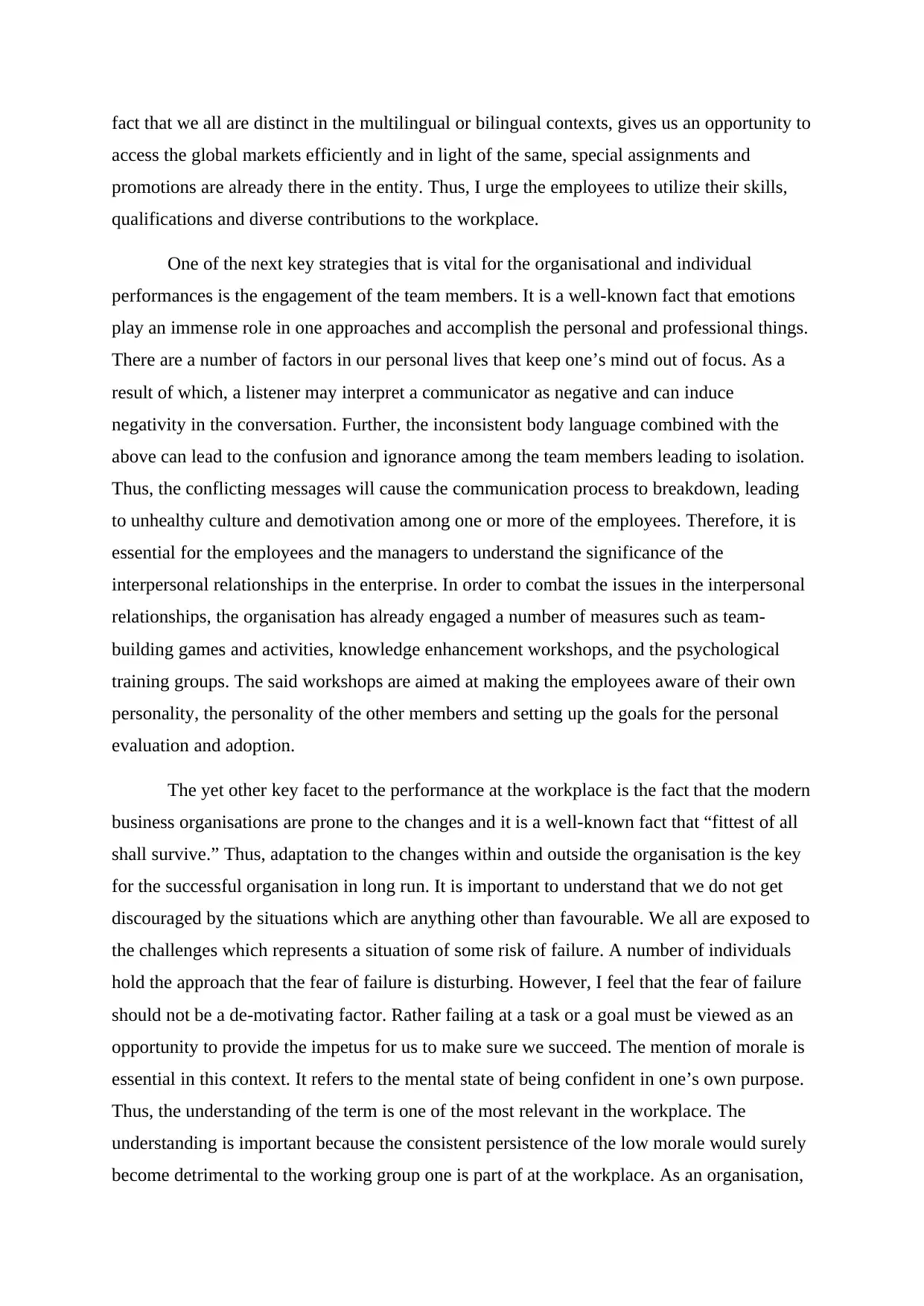
fact that we all are distinct in the multilingual or bilingual contexts, gives us an opportunity to
access the global markets efficiently and in light of the same, special assignments and
promotions are already there in the entity. Thus, I urge the employees to utilize their skills,
qualifications and diverse contributions to the workplace.
One of the next key strategies that is vital for the organisational and individual
performances is the engagement of the team members. It is a well-known fact that emotions
play an immense role in one approaches and accomplish the personal and professional things.
There are a number of factors in our personal lives that keep one’s mind out of focus. As a
result of which, a listener may interpret a communicator as negative and can induce
negativity in the conversation. Further, the inconsistent body language combined with the
above can lead to the confusion and ignorance among the team members leading to isolation.
Thus, the conflicting messages will cause the communication process to breakdown, leading
to unhealthy culture and demotivation among one or more of the employees. Therefore, it is
essential for the employees and the managers to understand the significance of the
interpersonal relationships in the enterprise. In order to combat the issues in the interpersonal
relationships, the organisation has already engaged a number of measures such as team-
building games and activities, knowledge enhancement workshops, and the psychological
training groups. The said workshops are aimed at making the employees aware of their own
personality, the personality of the other members and setting up the goals for the personal
evaluation and adoption.
The yet other key facet to the performance at the workplace is the fact that the modern
business organisations are prone to the changes and it is a well-known fact that “fittest of all
shall survive.” Thus, adaptation to the changes within and outside the organisation is the key
for the successful organisation in long run. It is important to understand that we do not get
discouraged by the situations which are anything other than favourable. We all are exposed to
the challenges which represents a situation of some risk of failure. A number of individuals
hold the approach that the fear of failure is disturbing. However, I feel that the fear of failure
should not be a de-motivating factor. Rather failing at a task or a goal must be viewed as an
opportunity to provide the impetus for us to make sure we succeed. The mention of morale is
essential in this context. It refers to the mental state of being confident in one’s own purpose.
Thus, the understanding of the term is one of the most relevant in the workplace. The
understanding is important because the consistent persistence of the low morale would surely
become detrimental to the working group one is part of at the workplace. As an organisation,
access the global markets efficiently and in light of the same, special assignments and
promotions are already there in the entity. Thus, I urge the employees to utilize their skills,
qualifications and diverse contributions to the workplace.
One of the next key strategies that is vital for the organisational and individual
performances is the engagement of the team members. It is a well-known fact that emotions
play an immense role in one approaches and accomplish the personal and professional things.
There are a number of factors in our personal lives that keep one’s mind out of focus. As a
result of which, a listener may interpret a communicator as negative and can induce
negativity in the conversation. Further, the inconsistent body language combined with the
above can lead to the confusion and ignorance among the team members leading to isolation.
Thus, the conflicting messages will cause the communication process to breakdown, leading
to unhealthy culture and demotivation among one or more of the employees. Therefore, it is
essential for the employees and the managers to understand the significance of the
interpersonal relationships in the enterprise. In order to combat the issues in the interpersonal
relationships, the organisation has already engaged a number of measures such as team-
building games and activities, knowledge enhancement workshops, and the psychological
training groups. The said workshops are aimed at making the employees aware of their own
personality, the personality of the other members and setting up the goals for the personal
evaluation and adoption.
The yet other key facet to the performance at the workplace is the fact that the modern
business organisations are prone to the changes and it is a well-known fact that “fittest of all
shall survive.” Thus, adaptation to the changes within and outside the organisation is the key
for the successful organisation in long run. It is important to understand that we do not get
discouraged by the situations which are anything other than favourable. We all are exposed to
the challenges which represents a situation of some risk of failure. A number of individuals
hold the approach that the fear of failure is disturbing. However, I feel that the fear of failure
should not be a de-motivating factor. Rather failing at a task or a goal must be viewed as an
opportunity to provide the impetus for us to make sure we succeed. The mention of morale is
essential in this context. It refers to the mental state of being confident in one’s own purpose.
Thus, the understanding of the term is one of the most relevant in the workplace. The
understanding is important because the consistent persistence of the low morale would surely
become detrimental to the working group one is part of at the workplace. As an organisation,
Paraphrase This Document
Need a fresh take? Get an instant paraphrase of this document with our AI Paraphraser
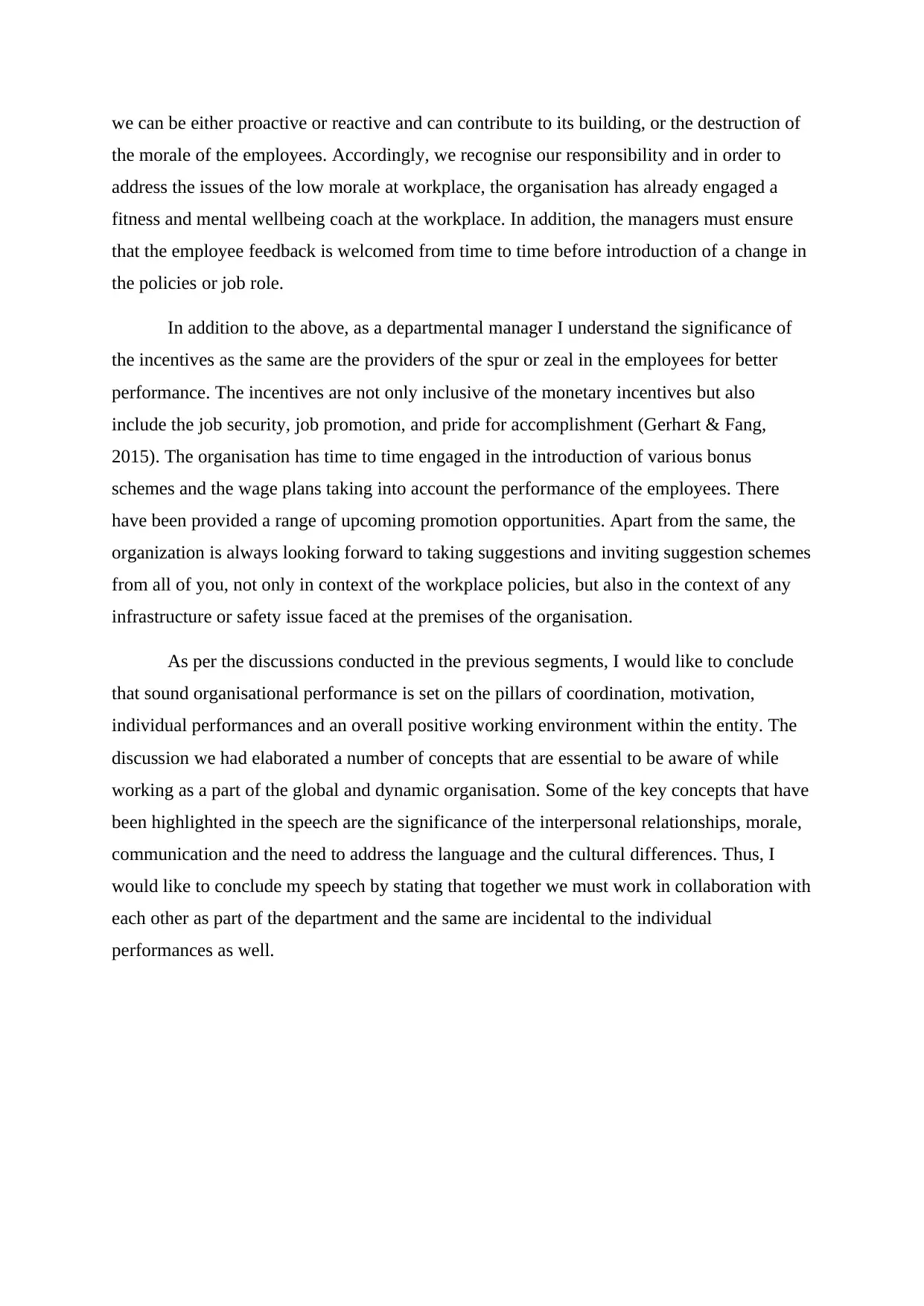
we can be either proactive or reactive and can contribute to its building, or the destruction of
the morale of the employees. Accordingly, we recognise our responsibility and in order to
address the issues of the low morale at workplace, the organisation has already engaged a
fitness and mental wellbeing coach at the workplace. In addition, the managers must ensure
that the employee feedback is welcomed from time to time before introduction of a change in
the policies or job role.
In addition to the above, as a departmental manager I understand the significance of
the incentives as the same are the providers of the spur or zeal in the employees for better
performance. The incentives are not only inclusive of the monetary incentives but also
include the job security, job promotion, and pride for accomplishment (Gerhart & Fang,
2015). The organisation has time to time engaged in the introduction of various bonus
schemes and the wage plans taking into account the performance of the employees. There
have been provided a range of upcoming promotion opportunities. Apart from the same, the
organization is always looking forward to taking suggestions and inviting suggestion schemes
from all of you, not only in context of the workplace policies, but also in the context of any
infrastructure or safety issue faced at the premises of the organisation.
As per the discussions conducted in the previous segments, I would like to conclude
that sound organisational performance is set on the pillars of coordination, motivation,
individual performances and an overall positive working environment within the entity. The
discussion we had elaborated a number of concepts that are essential to be aware of while
working as a part of the global and dynamic organisation. Some of the key concepts that have
been highlighted in the speech are the significance of the interpersonal relationships, morale,
communication and the need to address the language and the cultural differences. Thus, I
would like to conclude my speech by stating that together we must work in collaboration with
each other as part of the department and the same are incidental to the individual
performances as well.
the morale of the employees. Accordingly, we recognise our responsibility and in order to
address the issues of the low morale at workplace, the organisation has already engaged a
fitness and mental wellbeing coach at the workplace. In addition, the managers must ensure
that the employee feedback is welcomed from time to time before introduction of a change in
the policies or job role.
In addition to the above, as a departmental manager I understand the significance of
the incentives as the same are the providers of the spur or zeal in the employees for better
performance. The incentives are not only inclusive of the monetary incentives but also
include the job security, job promotion, and pride for accomplishment (Gerhart & Fang,
2015). The organisation has time to time engaged in the introduction of various bonus
schemes and the wage plans taking into account the performance of the employees. There
have been provided a range of upcoming promotion opportunities. Apart from the same, the
organization is always looking forward to taking suggestions and inviting suggestion schemes
from all of you, not only in context of the workplace policies, but also in the context of any
infrastructure or safety issue faced at the premises of the organisation.
As per the discussions conducted in the previous segments, I would like to conclude
that sound organisational performance is set on the pillars of coordination, motivation,
individual performances and an overall positive working environment within the entity. The
discussion we had elaborated a number of concepts that are essential to be aware of while
working as a part of the global and dynamic organisation. Some of the key concepts that have
been highlighted in the speech are the significance of the interpersonal relationships, morale,
communication and the need to address the language and the cultural differences. Thus, I
would like to conclude my speech by stating that together we must work in collaboration with
each other as part of the department and the same are incidental to the individual
performances as well.
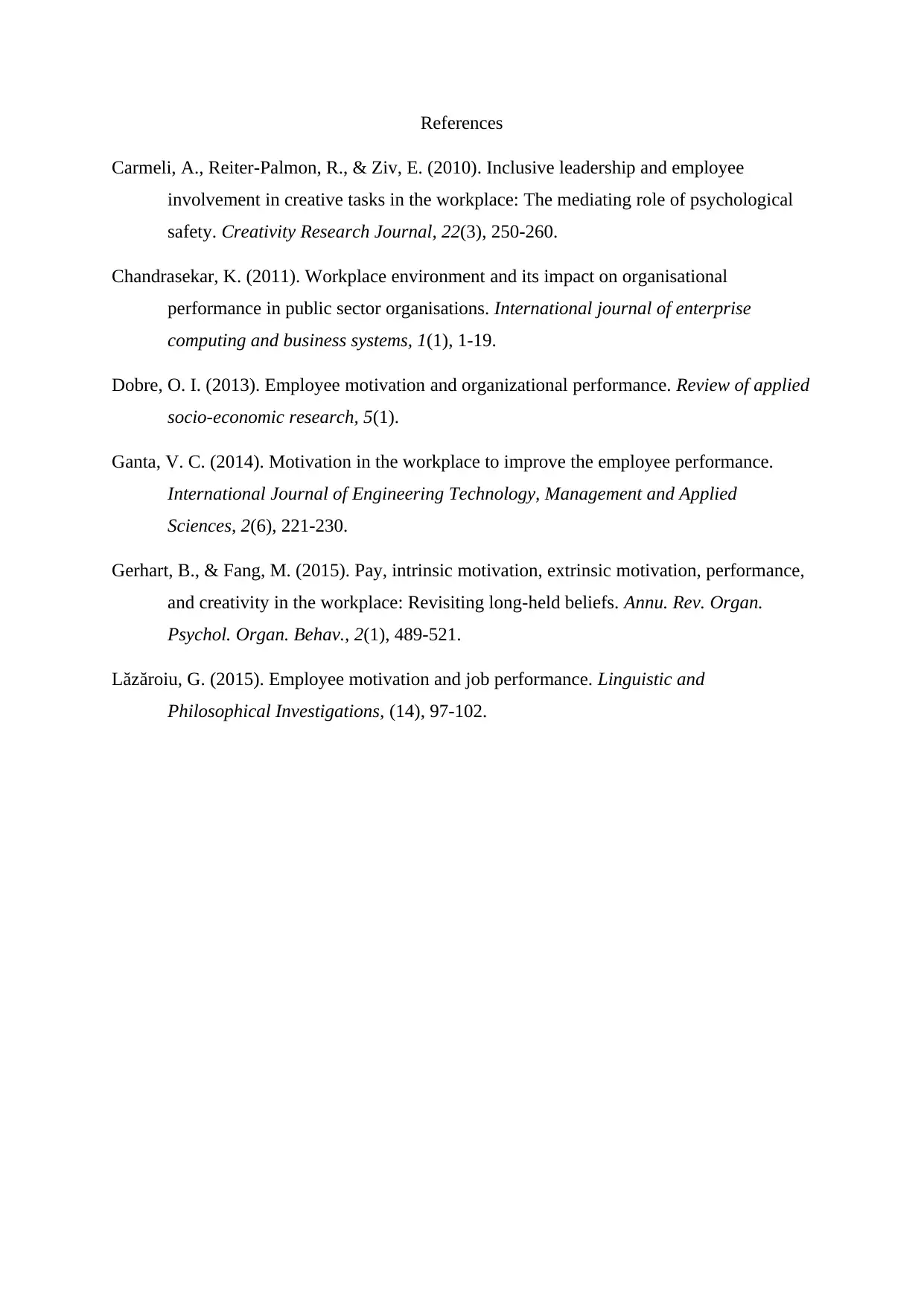
References
Carmeli, A., Reiter-Palmon, R., & Ziv, E. (2010). Inclusive leadership and employee
involvement in creative tasks in the workplace: The mediating role of psychological
safety. Creativity Research Journal, 22(3), 250-260.
Chandrasekar, K. (2011). Workplace environment and its impact on organisational
performance in public sector organisations. International journal of enterprise
computing and business systems, 1(1), 1-19.
Dobre, O. I. (2013). Employee motivation and organizational performance. Review of applied
socio-economic research, 5(1).
Ganta, V. C. (2014). Motivation in the workplace to improve the employee performance.
International Journal of Engineering Technology, Management and Applied
Sciences, 2(6), 221-230.
Gerhart, B., & Fang, M. (2015). Pay, intrinsic motivation, extrinsic motivation, performance,
and creativity in the workplace: Revisiting long-held beliefs. Annu. Rev. Organ.
Psychol. Organ. Behav., 2(1), 489-521.
Lăzăroiu, G. (2015). Employee motivation and job performance. Linguistic and
Philosophical Investigations, (14), 97-102.
Carmeli, A., Reiter-Palmon, R., & Ziv, E. (2010). Inclusive leadership and employee
involvement in creative tasks in the workplace: The mediating role of psychological
safety. Creativity Research Journal, 22(3), 250-260.
Chandrasekar, K. (2011). Workplace environment and its impact on organisational
performance in public sector organisations. International journal of enterprise
computing and business systems, 1(1), 1-19.
Dobre, O. I. (2013). Employee motivation and organizational performance. Review of applied
socio-economic research, 5(1).
Ganta, V. C. (2014). Motivation in the workplace to improve the employee performance.
International Journal of Engineering Technology, Management and Applied
Sciences, 2(6), 221-230.
Gerhart, B., & Fang, M. (2015). Pay, intrinsic motivation, extrinsic motivation, performance,
and creativity in the workplace: Revisiting long-held beliefs. Annu. Rev. Organ.
Psychol. Organ. Behav., 2(1), 489-521.
Lăzăroiu, G. (2015). Employee motivation and job performance. Linguistic and
Philosophical Investigations, (14), 97-102.
⊘ This is a preview!⊘
Do you want full access?
Subscribe today to unlock all pages.

Trusted by 1+ million students worldwide
1 out of 6
Related Documents
Your All-in-One AI-Powered Toolkit for Academic Success.
+13062052269
info@desklib.com
Available 24*7 on WhatsApp / Email
![[object Object]](/_next/static/media/star-bottom.7253800d.svg)
Unlock your academic potential
Copyright © 2020–2025 A2Z Services. All Rights Reserved. Developed and managed by ZUCOL.



